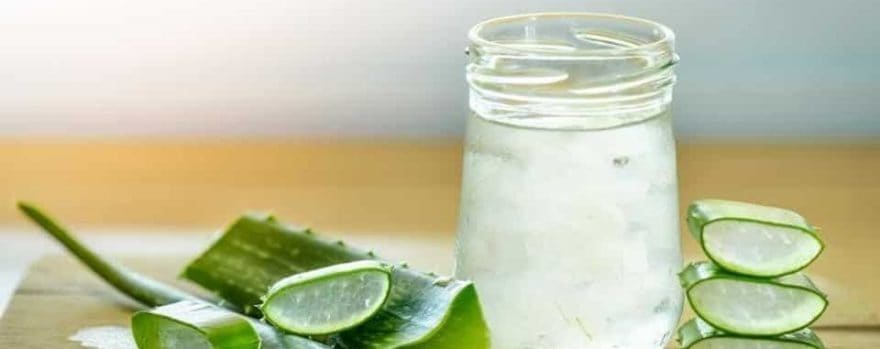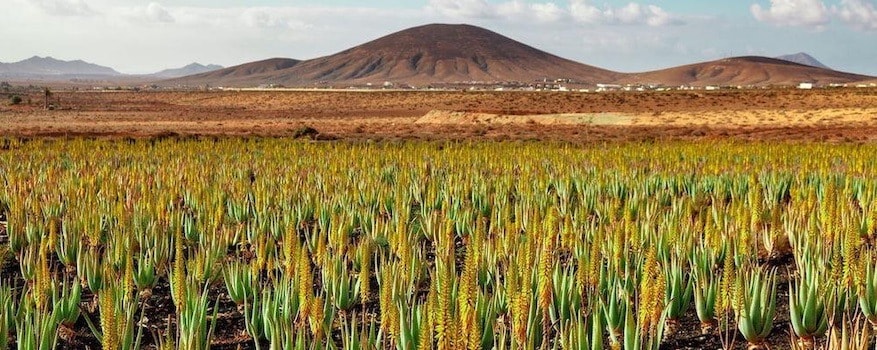VALIDATION SCIENTIFIQUE
Laure Fourchaud – 24.11.2021
Dr en physiologie de la nutrition
BENEFITS OF ALOE VERA
✓ Improves digestion
✓ Helps regulate blood sugar levels
✓ Alkalizing
✓ Relieves constipation
✓ Ultra-hydrating
✓ Supports natural defenses
What is aloe vera?
Aloe vera (Aloe barbadensis Miller) is a succulent plant, or fleshy plant, from the large family of Liliaceae, like the lily, the onion or the tulip. It is a xerophilous plant, meaning it originally grows in very arid, water-poor environments. Today it is found in tropical and warm temperate regions, thanks to its great capacity to adapt.
Now cultivated in the Americas, Africa, Europe and Asia, it has existed for millennia in the Middle East, where traces are found in Mesopotamia as early as the 2nd millennium BC. It was also a powerful remedy for treating wounds in Ancient Egypt, and it was adopted by traditional Chinese medicine and Ayurvedic medicine in India from the 10th century.

Aloe vera can reach up to 80 cm in height and has spiny green leaves, thick and fleshy, filled with water. The inside of the leaves is first made up of a yellow liquid latex, then a thick, colorless gel, the mucilage (see diagram below). It is the latter that is used in medicine, cosmetics and dietary supplements.

It is mainly used in dermatology: applied topically to burns, stings and other skin conditions such as genital herpes. Its soothing, moisturizing and healing properties are supported by medicine, and they also make it a cosmetic ally for enhancing the appearance of the skin.
But if aloe vera has all these benefits when used externally, it’s because it is also an impressive source of nutrients and active ingredients! And its low-calorie gel makes it a major dietary asset for people watching their weight.
Aloe vera is composed of 99% water, and the remaining 1% is a treasure trove of nutrients with properties that are highly beneficial to our health. Some of its internal benefits are correlated with its external effects, while others are quite surprising, such as rebalancing the gut microbiota.
Nutritional composition
- Proteins: 18 amino acids (including 7 essential: isoleucine, leucine, lysine, methionine, phenylalanine, threonine, valine)
- Vitamins: A, B1, B2, B3, B6, B9, B12, C, E
- Minerals and trace elements: calcium, chlorine, chromium, copper, iron, magnesium, manganese, phosphorus, potassium, sodium, zinc
- Enzymes and unsaturated fatty acids
- Polysaccharides: glucomannan and acemannan

The benefits of aloe vera
♻️ Improves digestion and rebalances the gut microbiota
Aloe vera contains a number of enzymes that aid digestion and regulate intestinal transit.
Its gel is rich in mucopolysaccharides, notably glucomannan and acemannan, which help reduce intestinal acidity, support the gut microbiota and therefore strengthen defenses.
It is particularly recommended for people suffering from irritable bowel syndrome and mild ulcerative colitis.
This study from the Baqiyatallah Research Center for Gastroenterology and Liver Disease in Tehran, conducted on 33 participants, shows that consuming aloe vera for 8 weeks helps reduce the pain and discomfort associated with irritable bowel syndrome.
This one, conducted by the Queen Mary School of Medicine in London on 30 participants, demonstrates improvement in ulcerative colitis when the plant was taken orally for 4 weeks.
🍬 Helps regulate blood sugar levels
Aloe vera consumption is recommended for diabetes because it has hypoglycemic and antidiabetic properties.
In Ayurvedic medicine, it is traditionally used for diabetes for its hypoglycemic properties.
This review reports that 5 out of 7 studies show that using aloe vera gel reduces blood sugar levels in diabetic patients.
⚖️ Alkalizing
Because of its composition, aloe vera is said to be alkalizing, that is to say, unlike acidifying foods (such as processed products), it will help regulate the pH of our cells and maintain a good acid-base balance, fundamental to our overall state of health.
🙏 Relieves constipation
powerful natural laxative because it is rich in hydroxyanthracene derivatives (HAD) (mainly aloin) and therefore helps with constipation. Be careful to use it only occasionally because it also has side effects (compounds that can irritate the intestinal mucosa). In case of constipation, psyllium and chia seeds are also recommended, as they are very high in fiber.
Its mucilage also helps increase the volume of water in the intestines.
The effectiveness of aloe vera latex in treating temporary constipation is recognized by the WHO, the Commission E (the German Commission on Phytotherapy) and ESCOP (European Scientific Cooperative on Phytotherapy).
💎Ultra-hydrating
The aloe vera plant contains 99% water, it is very hydrating for external use, but it is also the ideal food to treat or prevent dehydration. Maintaining a good level of hydration allows the body to eliminate toxins and impurities more easily.
Also read the 20 foods to protect and cleanse your liver
This hydration acts directly on the liver by supporting liver function and enabling better detoxification of the immune system. Its detoxifying and hydrating effects also promote our well-being.
🛡 Supports natural defenses
Polysaccharides such as acemannan contained in aloe vera support the body’s natural defenses by stimulating the proliferation of lymphocytes and white blood cells, which are the body’s defense cells against pathogens.
Aloe vera’s nutrient richness nourishes the microorganisms that inhabit the gut microbiota, thereby strengthening the body’s defenses.
🍑 Cleanses and protects the skin
Its consumption has a cleansing and protective effect on the skin, thanks to the many antioxidants and vitamins it contains. It’s a true ally for the beauty of the skin.
It helps, in particular, to treat acne, protect the skin from UV rays, and prevent aging.

How to consume aloe vera?
Aloe vera gel
Please note, we are referring here to the gel directly extracted from fresh leaves, also called mucilage, and not to cosmetic gels that are often processed for topical use.
The edible aloe vera gel can be found in pharmacies, in health food stores or shops specializing in dietetics. You can also make it yourself from large leaves bought at garden centers or organic grocery stores. In that case, be sure the variety is edible: aloe vera barbadensis miller.
Next, cut the leaf transversely with a knife and scrape out the clear gel, like a vanilla bean. Be careful not to collect the yellow latex, which is laxative and potentially irritating. Consume the gel raw and shortly after extraction so that it retains all its properties.
You can easily mix the gel into juices, smoothies or fresh vegetable soups. It is recommended not to consume it in a hot recipe so it retains its benefits as much as possible.

Aloe vera juice
Unless you make your juice from homemade gel, you can directly find aloe vera juices in health food stores, online retailers and the dietary sections of supermarkets. The highest-quality juices are made from the gel of fresh aloe vera leaves.
The pulp must be cold-stabilized so as to preserve its nutrients, without pasteurization or the addition of synthetic antioxidants. And it is better to choose them pure or very concentrated, at least 90%.
We recommend aloe vera juice for the lower part of the digestive system (intestine) and aloe vera gel for the upper part (stomach). The gel will soothe the lining of the esophagus in case of acid reflux.
Also read The benefits of aloe vera juice
Since the trend is toward healthy drinks, more and more aloe vera-based drinks are appearing in supermarkets. Unless otherwise stated, they are often made from powdered plant extract and contain only a small percentage. In fact, these juices are mostly sugar and water, and therefore have little nutritional value.
If you don’t like its taste, you can also take it as a dietary supplement in capsules and softgels. There are also teas and herbal infusions, but because their components are dry they are less rich nutritionally.
Taste of aloe vera
Aloe vera itself is rather bland, even bitter. However, its lack of flavor makes it easy to mix with other fruits and vegetables and to give it whatever taste you want. Add its juice to smoothies or gazpacho, and its mucilage, diced, to salads, for example. The latter is a thickening agent and will add body to your sweet preparations (coulis) or savory ones (fresh sauces).

Sustainable consumption: favor organic, fair-trade, and local aloe vera
✓ It is of course recommended to consume organic aloe vera, whether as gel, juice, or capsules. Organic certifications ensure optimal growing and manufacturing quality, without pesticide residues or heavy metals. You should be especially careful with aloe vera because chemical fertilizers can end up in the gel. Most organic leaves come from Spain and South America.
✓ If you buy aloe vera pulp or juice from emerging countries, check for fair trade certifications to help ensure better income for growers and producers.
✓ Since 2016, it has been possible to find organic aloe vera grown in France! A former ethologist grows it in a greenhouse in Brittany, in Pouldreuzic, and sells the fresh leaves at the farm or online. A good way to limit your carbon footprint and ensure product traceability.
Also read the Organic aloe vera: everything you need to know
Dosage
⌛️ The dosage of edible aloe vera depends on the desired effects. For a cure detox, prefer the seasonal changes, such as at the end of winter or summer, for example.
💧 As pure juice/gel: 50 ml per day maximum
💊 As capsules: 200 to 300 mg per day
Contraindications and side effects
The aloe vera latex used long-term or abusively can lead to the development of intestinal polyps, kidney disorders, and increase the risk of colorectal cancer. It can also cause abdominal pain and diarrhea. So be extremely careful when consuming it.
Internal use of this plant is not recommended in the following cases:
- Pregnancy
- Abdominal pain
- Hemorrhoids
- Kidney disease
- Crohn’s disease
- Ulcers
- Heart disorders
The aloe vera gel and its hypoglycemic effect can interact with antidiabetic medications, so medical advice should be sought before any treatment.
Taken as a detox treatment, the plant may cause diarrhea, a sign that the purge is working but that doses should be reduced or even stopped.
History and current cultivation
Aloe vera has been cultivated for millennia in the Middle East, North Africa, the Canary Islands and Cape Verde. It is now also present in Europe, the Americas and Asia.
It originates from the Middle East: traces of it are found in Mesopotamia, where its benefits for the skin and health are mentioned as early as the 2nd millennium BC on clay tablets. Considered a plant of immortality, it was also a powerful remedy for treating wounds in Ancient Egypt, as indicated by the Ebers Papyrus, one of the oldest medical treatises.
In Ancient Greece, Aristotle is said to have advised Alexander the Great to establish an Ionian colony on the island of Socotra to take advantage of its abundance of aloes. During Ancient Rome, Pliny the Elder gives a detailed description of this plant in his encyclopedia Natural History (book XXVII, V).
It became part of traditional Chinese medicine and Ayurvedic medicine in India from the 10th century. The Americas began importing the plant from the 17th century.
Its production and global trade are exponential. In 2015, aloe vera production reached 60,720 tons.
Detailed nutritional values of aloe vera
This data has been compiled and verified for Darwin Nutrition by Laure Fourchaud, PhD in nutrition physiology.
| Aloe Vera | /100g | %AR* | /5g (1cc) | %AR |
| Energy (kcal) | 4,54 | 0,22 | 0,22 | 0,01 |
| Fiber (g) | 1 | 3,33 | 0,05 | 0,16 |
| Water (g) | ||||
| Macronutrients | ||||
| Protein (g) | 0,04 | 0,08 | 0,002 | 0,004 |
| Carbohydrates (g) | 0,63 | 0,24 | 0,031 | 0,012 |
| Of which sugars (g) | ||||
| Fat (g) | 0,01 | 0,014 | 0 | 0 |
| Minerals | ||||
| Calcium (mg) | 103 | 12,87 | 5,15 | 0,64 |
| Iron (mg) | — | — | — | — |
| Copper (mg) | — | — | — | — |
| Magnesium (mg) | 69 | 18.4 | 0.16 | 0.92 |
| Manganese (mg) | 5.6 | 280 | 0.28 | 14 |
| Phosphorus (mg) | — | — | — | — |
| Potassium (mg) | 287 | 14.35 | 14.35 | 0.71 |
| Sodium (mg) | 23 | 0.92 | 1.15 | 0.046 |
| Salt (g) | ||||
| Zinc (mg) | 0.46 | 4.6 | 0.02 | 0.23 |
| Vitamins | ||||
| Vitamin A (mg) | ||||
| Vitamin C (mg) | ||||
| Vitamin E (mg) | 84 | 700 | 4.2 | 35 |
| Vitamin B1 (mg) | ||||
| Vitamin B2 (mg) | ||||
| Vitamin B3 (mg) | ||||
| Vitamin B4 / choline (mg) | ||||
| Vitamin B5 (mg) | — | — | — | — |
| Vitamin B6 (mg) | ||||
| Vitamin B9 or folate (µg) | ||||
| Vitamin B12 (µg) | ||||
| Vitamin K (μg) | — | — | — | — |
*%AR : % Reference intake for an adult
Antioxidant compounds: phenolic acids (anthraquinones): aloin and emodin
Other compounds:
- Mucopolysaccharides (acemannan)
- Saponins
- Sterols: sitosterol, campesterol and lupeol
- Hormones: auxin and gibberellin
Sources and scientific studies
Hossein Khedmat, Ashraf Karbasi, Mohsen Amini, Aghdas Aghaei, and Saeed Taheri, 2013. Aloe vera in treatment of refractory irritable bowel syndrome: Trial on Iranian patients.
L. Langmead, R. M. Feakins, S. Goldthorpe, H.Holt, E. Tsironi, A. De Silva, D. P. Jewell & D.S.Rampton 2004. Randomized, double-blind, placebo-controlled trial of oral aloe vera gelfor active ulcerative colitis.
Ngo MQ, Nguyen NN, Shah SA, 2010. Oral aloe vera for treatment of diabetes mellitus and dyslipidemia.
Añibarro-Ortega et al, Compositional Features and Bioactive Properties of Aloe vera Leaf (Fillet, Mucilage, and Rind) and Flower, 2019
Amar Surjushe et al. Aloe vera : a short review. Indian J Dermatol. 2008 ; 53 (4) : 163 – 166
Marshall JM. Aloe vera gel: What is the evidence? Pharma Jr. 1990 ; 24 : 360–2.
Shelton M. Aloe vera, its chemical and therapeutic properties. Int J Dermatol. 1991 ; 30 : 679–83.



